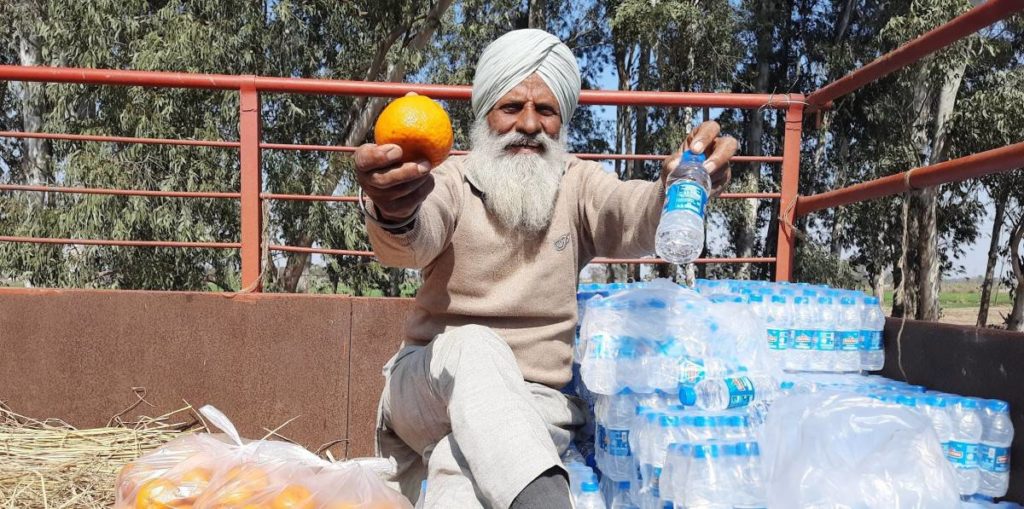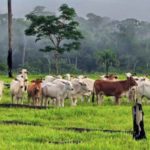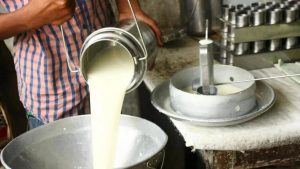
By linking the Kisan Credit Card to price floors and crops as collateral, the government can ameliorate the agrarian distress by investing in an agrarian programme for supply management.
As the government and farmers are battling each other on Punjab-Haryana borders over the right to fair price, we need to ask the question – how will the minimum price floors be implemented?
Financially speaking there is a consensus of a requirement of Rs 1.5 lakh crore as financial support, but agriculturally speaking how will the system work? The ‘New Deal Farm’ programme from the US may have a potential answer.
The origin of Minimum Support Price (MSP) idea
It was Dr Frank Parker of USAID who gave the MSP idea to the Indian government. He suggested the price floors drawing from an FDR (Franklin Roosevelt) New Deal agrarian policy that transformed rural America and increased farmers net income by 115% in 10 years between 1942 and 1952. This was a golden period not just for the farmers, the industry got raw materials for fair price and consumers were not pinched too.
The American parity system was built on price floors (minimum and ceiling floors), growing quota, government grain reserves and co-operative and individual systems for growing quotas, among other things. Instead of losing money, the government gained revenue and also directly added to rural American economy. The vestiges of the same idea are still embodied in our agrarian and food institutions likes MSP, Food Corporation of India (FCI), National Agricultural Cooperative Marketing Federation (NAFED), etc.
FDR’s New Deal
The American farmers were destroyed by the summer of the 1920. By June, prices from corn to hogs all had crashed, ending the World War I high demand and high prices. For instance, in a matter of five months the price of corn fell from $1.83/bushel to less than 70 cents/bushel at the Chicago market.
Thousands of farming families were foreclosed and rural America was battling over production given that more land was brought under agriculture under during World War I years. For example, the area under wheat had increased from 48 million acres in 1914 to over 75 million by 1919.
With the crash, rural America was being plagued by hyperinflation on land prices, speculation and excessive debt. Meanwhile, by 1922 American agricultural exports had fallen to the value of $1,883,315,000; 50% decrease from 1919.
The prices didn’t rise again for a long time as by 1929 the Great Depression had rocked the economy. In over production, supply mismanagement and falling incomes, rural America was almost on the precipice for collapse.
The situation is best described in a letter – pleading for a farm debt moratorium – to then agriculture secretary Henry C Wallace, “Why should we all have our homes taken from us”.
Another Georgia sharecropper wrote to the Agriculture Secretary, “This fall not only will i lose my home and everything in it, but hundreds, perhaps thousands, will be in my conditions, homeless. Unless, the farmers gets 35c to 40c for his cotton, we will be ruined….”
To prevent a rural meltdown Franklin Roosevelt’s government introduced a New Deal for farmers built upon price floors, grain reserves and recourse loans. It began with key agricultural commodities like corn (1933), cotton (1933), wheat, tobacco (1937) and then even spread into the meat, poultry, fresh vegetables and to even dairy farmers.
From an agricultural policy perspective, the period between 1942-1952 was also called the parity years where farmers got 100% value of their produce assured to them by government loans.
So how did the programme work? In principle, the USDA after analysis of agri-climate, market, demand-supply and carry over calculations suggested price floors for various agricultural commodities likes wheat, corn, rye, etc. to the Congress. The Congress then ratifies the price floors each season and announces them to the farmers.
The government agencies worked with the farmers directly and also through large farmers’ co-operatives like the Burley tobacco co-operative in Kentucky. But in principle, before the sowing, every farmer received their growing quotas for their various agricultural commodities along with the price floors.
At harvest time, farmers went to the co-operative market yards or grain elevators/silos or to the government grain reserves and deposited their produce and got it sealed and inspected by the government agents.
After receiving the grain storage certificate, the farmers went to the bank, showed the certificate and secured a nine month loan equivalent of 90% value (the percentage could differ from year to year, but 90% is a good average) of the crop.
The bank gave the farmers a non-recourse loan, which was guaranteed by the US government Commodity Credit Corporation (CCC), and used the stored crop as a collateral.
During the nine-month period, if the farmer is successful in selling the crop in the open market he/she/they return the loan amount at a low interest to the bank. If the farmer isn’t able to sell the crop, then the government takes over the crop collateral and transfers the produce to government reserves and the CCC pays the banks.
Only a small part of the agriculture produce landed in the grain reserves, the rest of it was brought and sold in the open market. The grain reserves acted as a bulwark against inflation and farmers were given growing quota based on carry-over reserves from the previous year.
In this scenario, the farmers receive the fair price and also the money required for the next sowing without failing into debt. The government by controlling the agriculture produce through reserves and supply management also ensured that industries get a regulated supply of raw material. This policy made the industry, farmers and consumers happy, as all were being dealt with fairly.
The co-operative mode of this programme worked to keep millions of agrarian families in Kentucky growing region afloat. This model was promoting subsistence farming vs big farm. The small family farms could generate enough cash income from one or two acres of a tobacco crop only because of a price floor and guaranteed purchase programme.
The result of this programme was that farmers’ net incomes increased by 115% between 1942-1952 when compared with 1920-1932 period, increasing rural prosperity and restarting the economy.
After 1952, price floors over next four decades was lowered, and then ended due to corporate pressure and mismanagement. A full 100% of parity for agriculture as a whole was never achieved again after 1952 though a few individual crops continued to achieve parity during the 1950s, such as burley tobacco and peanuts, according to USDA data.
After the end, millions were forced from the farms, the economic despondency reigned in once prosperous areas like Iowa, Kansas, Kentucky, etc.
The other unique thing about the programme was that it calculated price floors not on cost of production estimates but used a new base line method. They selected a base line period 1910 to 1914. These years were selected because within this period, the price of the agricultural commodities rose at par with other market based commodities.
Each year after was adjusted for inflation from the base line. They selected this formula because cost of production method is contingent on new technology, volatile agri-inputs, innovations, etc and hence can change drastically in the future. But the price of agricultural commodities over time will reflect general inflation and factor in newer production methods too.
In summary, the programme worked on four general principles – first being the minimum price support floors which were backed by supply reduction quotas to meet supply and demand goals. Next is the guaranteed procurement and a ceiling price floors for the markets.
In case the agricultural commodity price reach a price ceiling, the government flooded the market with reserve grains/produce from the food/grain reserves stabilising the prices immediately. The whole system is based on a non-recourse loans and hence not a government subsidy for the farmers.
New Deal for India
The big question now is – can this programme be adapted for India?
Potentially yes. And lets begin with institutions. India already has a robust agricultural extension system which is supported by government-backed grain procurement through FCI, NAFED, and other state agencies, much like post World War II USA.
We have APMC (Agricultural Produce Market Committees) mandis and the price floor mechanism is already working in India. As for the financial credit, government has a robust rural credit system through the kisan credit card (KCC). And the final straw the government is already organising farmers into Farmer Producer Organisations (FPOs) and co-operative societies.
We have the CACP (Commission for Agricultural Costs and Prices) which is setting prices floors for 23 crops each season. So our Indian agrarian system is very aligned to receiving such a policy intervention. To run it smoothly, additional investments in storage and marketing will be required.
At the farmers level, government first has to take stock of the KCC data and get an estimate of the number of farmers linked to the KCC. After this step, a through voluntary pilot programme will create clusters, potentially organic clusters, for enrolling farmers for various crops.
The government can begin with wheat, rice, legumes, oilseeds and a programme for potatoes, onions and tomatoes. In the meanwhile the governments needs to stress on PPP (public-private partnership) to increase decentralised grain and perishable storage godowns linked to Food Corporation of India (FCI) and other state agencies, who can store the block level grains.
The enrolled farmers upon harvest, will have the option of selling in the open market or else depositing the grain/produce to the government back godown. After depositing the grain, the farmers can get a certificate making the grain the collateral for a loan.
Farmers can approach any government or private bank for 90% value loans based on the price floor for nine months. In case, the farmers find better price in the open market they can sell and repay the credit, interest and storage costs, else the grain/produce can be be sent over to the FCI and the state agency. After the sale of the produce, the bank or KCC provider can be repaid.
To battle rural indebtedness, farmers should also be allowed to repay their KCC debt with crops or produce through this mechanism. This will also stimulate the agricultural processors and the so called middle layer to curb excessive profit making and trade fairly.
To check overproduction, there can be a per acre limit of government procurement for certain commodities based upon the agro-climate conditions of the region. For example, there won’t be paddy procurement centres in dry parts of Rajasthan, but of legumes or oilseeds instead.
The FPOs and co-operatives societies linked directly with the programme would need to discipline members on production quotas, so all the members are benefited.This will be easily done as 70% of Indian farmers are small land holding farming families with under two acres of land. So their size makes them best suited for subsistence agrarian programme through which they can be plugged into the agrarian supply programme and also be given a cash income through price floors directly.
NABARD can provide the refinancing for KCC loans or back the crop collaterals.
What is needed to implement this system?
Political will.
Expanding the agrarian institutions to grow into new roles of marketing, banking and storage is already the government’s agenda.
NAFED, Agricultural and Processed Food Products Export Development Authority or APEDA can also look for foreign markets for Indian surplus produce.
By linking KCC to price floors and crops as collateral, the government can highly ameliorate the agrarian distress by investing in an agrarian programme for supply management. If successful, this programme will also ensure MSP for farmers and food sovereignty for India.
Indra Shekhar Singh is an independent agri-policy analyst and writer. He was the former director, policy and outreach, at NSAI. He also hosts The Wire’s agriculture talk show, Krishi ki baat/Farm Talks. He tweets @indrassingh.

















